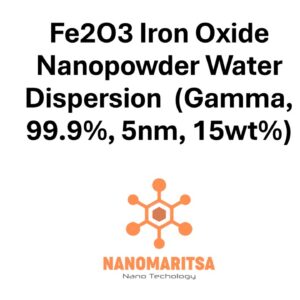Metal Oxide Dispersions
Titanium Oxide Nanopowder Water Dispersion (TiO2, Rutile, 15 wt%, 5-15 nm)
€96.00
CompareTitanium Oxide Nanopowder Water Dispersion (TiO₂, Rutile, 15 wt%, 5–15 nm) is a water-based suspension of titanium dioxide (TiO₂) nanoparticles in the rutile crystalline phase. Here’s an in-depth explanation:
1. Composition:
- Titanium Dioxide (TiO₂):
- A widely used metal oxide with excellent photocatalytic, optical, and chemical stability properties.
- Rutile Phase:
- One of the crystalline forms of TiO₂, characterized by:
- Higher refractive index.
- Excellent thermal and chemical stability.
- Lower photocatalytic activity compared to the anatase phase, making it less reactive in some conditions.
- One of the crystalline forms of TiO₂, characterized by:
- Nanoparticles (5–15 nm):
- Ultra-fine particles with an average size range of 5 to 15 nanometers.
- Nano size ensures a high surface area and unique optical properties.
- 15 wt%:
- The dispersion contains 15% by weight of TiO₂ nanoparticles, with the remaining 85% being water.
- Water-Based Dispersion:
- Uniformly suspended nanoparticles in water for easy application.
2. Key Properties:
- High Refractive Index:
- Provides excellent light scattering and UV shielding properties.
- Chemical Stability:
- Inert and resistant to corrosion and degradation.
- Hydrophilic Surface:
- Disperses well in aqueous systems.
- Photocatalytic Activity:
- Rutile TiO₂ has lower photocatalytic activity than anatase, reducing oxidative side effects in certain applications.
- Thermal Stability:
- Stable at high temperatures, ideal for heat-resistant coatings and materials.
- Uniform Dispersion:
- Ensures nanoparticles are evenly distributed without agglomeration.
3. Applications:
- Coatings:
- Used in protective, decorative, or UV-resistant coatings for surfaces like glass, plastics, and metals.
- Sunscreens and Cosmetics:
- Provides UV protection due to its high refractive index and light-blocking properties.
- Photocatalysis:
- Suitable for applications like self-cleaning surfaces, air purification, and water treatment.
- Pigments:
- Adds whiteness, opacity, and brightness in paints, inks, and plastics.
- Composites:
- Enhances mechanical, thermal, and optical properties in polymer and ceramic composites.
- Energy:
- Used in dye-sensitized solar cells and other energy-harvesting applications.
- Electronics:
- Serves as a dielectric material or optical layer in microelectronics and sensors.
4. Advantages:
- Ready-to-Use:
- Pre-dispersed in water, simplifying application and reducing preparation steps.
- Environmentally Friendly:
- Water-based formulation avoids hazardous organic solvents.
- Nano-Scale Benefits:
- High surface area and enhanced optical performance.
- Versatile:
- Suitable for a wide range of industrial, environmental, and cosmetic applications.
- Stable Rutile Phase:
- Offers high stability and durability under thermal and UV exposure.
5. Handling and Storage:
- Handling:
- Shake or stir thoroughly before use to ensure uniform nanoparticle distribution.
- Use gloves and protective equipment to avoid skin or eye contact.
- Storage:
- Store in a cool, dry place away from direct sunlight.
- Avoid freezing or overheating, as these conditions can destabilize the dispersion.
- Safety:
- TiO₂ is generally considered safe, but avoid inhalation of aerosols or mist and prolonged skin exposure.
This TiO₂ water dispersion is a versatile material ideal for applications requiring stability, UV protection, or enhanced optical properties. The rutile phase ensures durability and reduced photocatalytic activity, making it suitable for a broad range of uses in coatings, cosmetics, and functional materials.
SKU: MN07NPD0105
Category: Metal Oxide Dispersions
| Measurement (ml) | 100 ml, 500 ml, 1000 ml |
|---|
Related products
-
Metal Oxide Dispersions
Fe2O3 Iron Oxide Nanopowder Water Dispersion (Gamma, 99.9%, 5nm, 15wt%)
0 out of 5(0)SKU: MN07NPD0123€448.00 This product has multiple variants. The options may be chosen on the product page -
Metal Oxide Dispersions
Titanium Oxide Nanopowder Water Dispersion (TiO2, Anatase, 15 wt%, 5-15 nm)
0 out of 5(0)SKU: MN07NPD0109€96.00 This product has multiple variants. The options may be chosen on the product page -
Metal Oxide Dispersions
Aluminum Oxide Nanopowder Water Dispersion (Al2O3,Gamma, 20wt%, 10nm)
0 out of 5(0)SKU: MN07NPD0102€80.00 This product has multiple variants. The options may be chosen on the product page -
Metal Oxide Dispersions
Titanium Oxide Nanopowder Water Dispersion (TiO2, Rutile, 40wt%, 30nm)
0 out of 5(0)SKU: MN07NPD0108€144.00 This product has multiple variants. The options may be chosen on the product page






